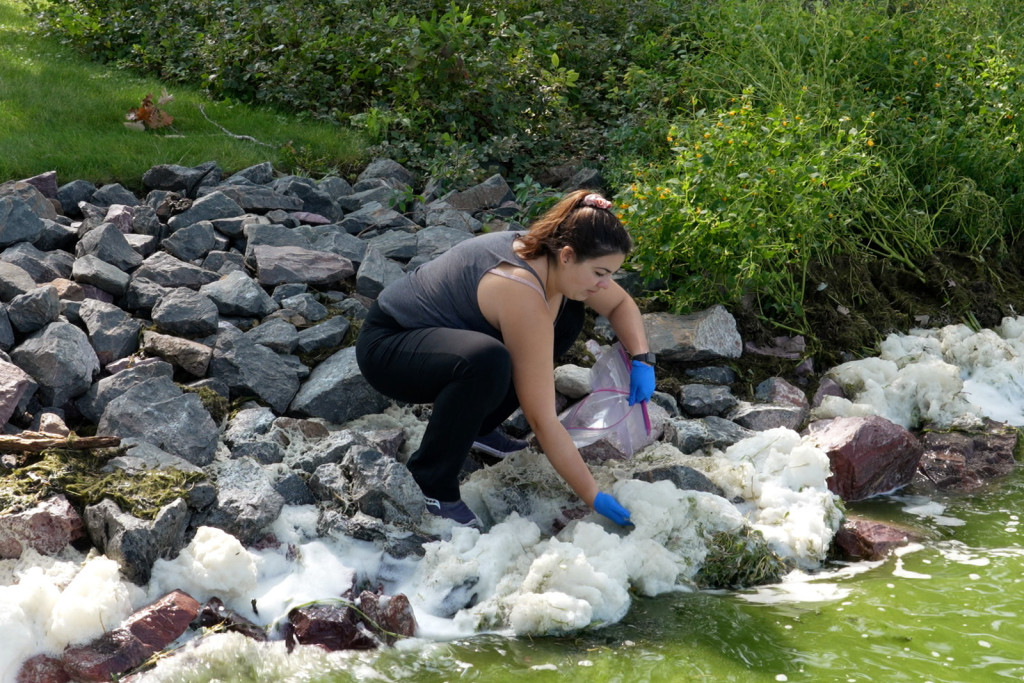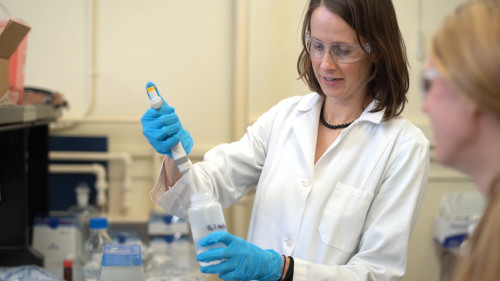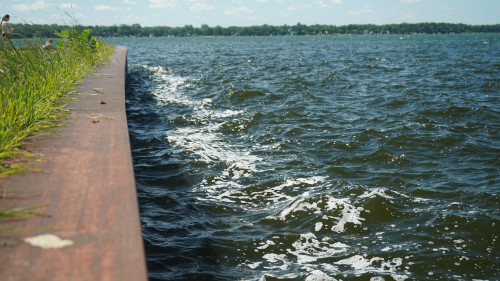
Summer Sherman, who conducted this research while a post doctoral researcher in Christy Remucal's lab, collects naturally occurring foam from the surface of Lake Monona. Photo by Elise Mahon
According to a new study of rivers and lakes in Wisconsin, natural foams from these bodies of water contain much higher concentrations of per- and polyfluoroalkyl substances (PFAS) than the water below them.
Thirty-six different kinds of PFAS compounds were analyzed in samples of both the foams and water surface microlayers of 43 Wisconsin rivers and lakes. The study, which published in Environmental Science & Technology, also revealed that foams, generally off-white and found along shorelines, are not necessarily an indicator of elevated contamination levels in the entire water body.
"We studied many different lakes and found PFAS in all of them. The PFAS concentrations were high in the foams even if the concentrations in the water were relatively low," said Christy Remucal, a professor with the University of Wisconsin-Madison Department of Civil and Environmental Engineering and interim director of the University of Wisconsin Aquatic Sciences Center.

Christy Remucal is a leading expert on PFAS, especially in the Great Lakes region. Photo courtesy of Wisconsin Sea Grant.
Remucal stressed the need to avoid the foams because of the contaminants' warning-worthy levels. "The chemical we found most in the foam is PFOS, which is one of the PFAS chemicals that is driving fish advisories and drinking water regulations," she said. "The highest PFOS concentrations we measured in foam were almost 300,000 nanograms per liter and, for comparison, the federal drinking water regulation is 4 nanograms per liter."
She continued, "The main way people are exposed to PFAS is through ingestion…Obviously, people aren't drinking foam. I would be more concerned about, for example, a kid who plays in the foam and then goes to grab a handful of snacks. You could potentially have some oral exposure that way."
There are more than 9,000 different PFAS compounds, which are often referred to as "forever chemicals" because some PFAS do not readily break down in the environment. For decades, they have been used to make a wide range of products resistant to water, grease, oil and stains. They are also found in some types of firefighting foams, which are a major source of environmental PFAS contamination. Exposure to high concentrations of PFAS have been shown to have adverse effects on human health and higher incidence of cancer.
The levels in the new study validate a current Wisconsin Department of Natural Resources warning, as well as a similar freshwater foam warning in Michigan and one for saltwater foam in the Netherlands. They are timely cautions as spring and summer come to Wisconsin and people and their pets spend more time hiking along open water or engaging in paddle sports and swimming where foams can be found.
The study by Remucal, postdoctoral co-investigators Summer Sherman-Bertinetti and Sarah Balgooyen along with graduate students Kaitlyn Gruber and Edward Kostelnik was funded by a grant from the Wisconsin Sea Grant College Program.

Foams accumulate naturally on freshwater rivers and lakes, especially on windy days. Photo courtesy of Wisconsin Sea Grant
Integral to the study were dozens of citizen volunteers and the Wisconsin Department of Natural Resources who alerted the research team to the presence of foams. This was critical, Remucal said, because sampling was opportunistic-foams are fleeting, stirred up by wind and mixing with water, they can dissipate as quickly as they appear.
While the most pressing findings from the study are the high levels of contamination in the foams, Remucal and her team found that PFAS levels in samples of water surface microlayers were slightly higher than underlying water as well. Studying the microlayers in the surface water, where the air and water interface, help illuminate their understanding of how PFAS move in groundwater. Now, researchers can compare PFAS movement in surface water to their movement in groundwater.
The work also illuminates the efforts of other research groups around the world exploring a possible path of PFAS cleanup. Because PFAS are surfactants, which means they are drawn to the air and water interface, they may move out of the water below and toward the bubbles in foam. When concentrated like this, the contaminants could be removed.






